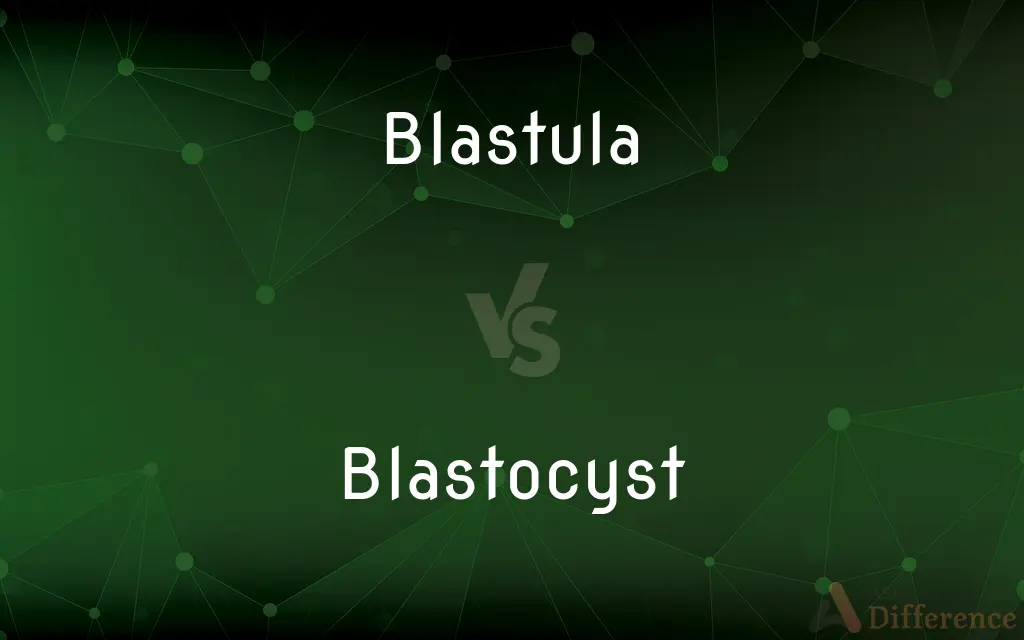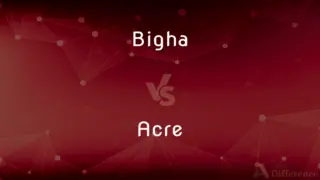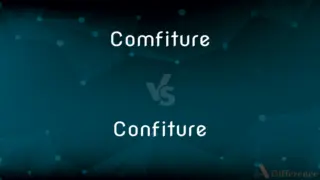Blastula vs. Blastocyst — What's the Difference?
By Tayyaba Rehman — Updated on November 7, 2023
A blastula is an early embryonic stage with a hollow sphere of cells, while a blastocyst is a mammalian structure with differentiated cells.

Difference Between Blastula and Blastocyst
Table of Contents
ADVERTISEMENT
Key Differences
The blastula is an early stage in embryonic development, common to many animals, characterized by a sphere of cells (blastomeres) surrounding a fluid-filled cavity (the blastocoel). In contrast, the blastocyst is a stage specific to mammalian embryos, which not only includes a cavity and an outer cell layer but also features an inner cell mass that will eventually form the embryo.
A blastula forms following several rounds of cell division after fertilization, leading to a hollow ball structure. This is a very general stage of development. On the other hand, a blastocyst is a more advanced stage following the blastula phase in mammals, indicating the start of differentiation with specific areas destined to become the embryo proper and others to form extra-embryonic structures.
The transition from a blastula to a blastocyst involves significant changes, including cell signaling and differentiation. The blastocyst's inner cell mass is analogous to the blastoderm of birds and reptiles, but the latter does not form a structure as complex as the mammalian blastocyst.
In non-mammalian species, the blastula continues to develop into stages like the gastrula, where germ layers form. In mammals, the blastocyst implants into the uterine wall before this transition, a step that is critical for further development and establishment of the pregnancy.
The blastula is universally present across various taxa in the animal kingdom, signifying a shared evolutionary pathway. The blastocyst, however, represents a specialization within the class Mammalia, underlining the unique aspects of mammalian development, particularly the intimate association between the mother and the developing embryo.
ADVERTISEMENT
Comparison Chart
Definition
An early, hollow spherical stage of embryonic development.
A mammalian-specific stage with a cavity, outer cells, and an inner cell mass.
Presence of Inner Cell Mass
No
Yes
Level of Cell Differentiation
Undifferentiated
Differentiated cells present
Occurrence in Animals
Universal in many animals
Specific to mammals
Role in Development
Precedes gastrulation and other development stages
Precedes implantation and gastrulation in mammals
Compare with Definitions
Blastula
A blastula is a spherical layer of cells surrounding a fluid-filled cavity in an embryo.
The frog eggs have now developed into blastulas, each a tiny sphere of potential life.
Blastocyst
A blastocyst is a mammalian embryonic stage with differentiated cells forming an inner cell mass.
The human embryo at the blastocyst stage is ready for implantation into the uterine lining.
Blastula
A blastula is the stage of early animal embryogenesis that follows the morula stage.
As the sea urchin embryo reached the blastula stage, it began to exhibit cellular movement.
Blastocyst
Blastocyst is an advanced embryonic stage characterized by an outer cell layer and a fluid-filled cavity.
In vitro fertilization success is often assessed by the formation of a healthy blastocyst.
Blastula
A blastula is a multicellular stage in which cells form a hollow sphere.
The blastula is critical to study because it's a key stage in embryonic development.
Blastocyst
A blastocyst is the form an embryo takes before it implants in the uterus of mammals.
Researchers marveled at the blastocyst's potential as it prepared for the critical step of implantation.
Blastula
Blastula is an embryonic stage post-fertilization characterized by a hollow ball of cells.
Scientists observed the zebrafish embryos, noting the transition from the morula to the blastula stage.
Blastocyst
Blastocyst refers to a stage in mammalian development where an embryo consists of a sphere with a cavity.
The blastocyst, with its distinct inner cell mass, was clearly visible five days post-fertilization.
Blastula
Blastula refers to an early embryo that has not yet begun to form distinct germ layers.
Under the microscope, the blastula appeared as a perfect circle of cells.
Blastocyst
A blastocyst is a structure formed in the early development of mammals, preceding the formation of germ layers.
The blastocyst's inner cell mass will give rise to the entire embryo, a fact that fascinates embryologists.
Blastula
An early embryonic form produced by cleavage of a fertilized ovum and consisting of a spherical layer of cells surrounding a fluid-filled cavity. Also called blastosphere.
Blastocyst
The blastocyst is a structure formed in the early development of mammals. It possesses an inner cell mass (ICM) which subsequently forms the embryo.
Blastula
(embryology) An early form in the development of an embryo, consisting of a spherical layer of cells filled with fluid; a blastosphere.
Blastocyst
The modified blastula that is characteristic of placental mammals. Also called blastodermic vesicle.
Blastula
That stage in the development of the ovum in which the outer cells of the morula become more defined and form the blastoderm.
Blastocyst
(biology) The mammalian blastula
Blastula
Early stage of an embryo produced by cleavage of an ovum; a liquid-filled sphere whose wall is composed of a single layer of cells; during this stage (about eight days after fertilization) implantation in the wall of the uterus occurs
Blastocyst
The germinal vesicle.
Blastocyst
The blastula of mammals
Common Curiosities
What follows the blastula stage in non-mammals?
In non-mammals, the blastula often progresses to the gastrula stage.
Does a blastula have differentiated cells?
No, a blastula's cells are generally not differentiated.
Can the blastula stage be seen in human development?
Humans do have a stage comparable to a blastula, but it quickly transitions to a blastocyst.
Is the blastula present in all animal embryos?
Most multicellular animals exhibit a blastula stage during early embryonic development.
What happens to the blastocyst during human pregnancy?
The blastocyst implants into the uterine wall, initiating pregnancy.
What is a blastula?
A blastula is an embryonic stage consisting of a hollow sphere of cells in early development.
What distinguishes a blastocyst from a blastula?
A blastocyst has an inner cell mass and distinct cell layers, unlike the undifferentiated cells of a blastula.
What is a blastocyst?
A blastocyst is a stage in mammalian embryonic development that features differentiated cells.
Does a blastocyst have a blastocoel?
Yes, a blastocyst has a blastocoel, which is the fluid-filled cavity.
Can blastocysts be used in research?
Yes, blastocysts are often used in embryological research and in vitro fertilization processes.
Is the blastocyst unique to mammals?
Yes, the blastocyst stage is specific to mammals.
Are the cells of a blastocyst pluripotent?
Yes, the cells in the inner cell mass of the blastocyst are pluripotent.
How long after fertilization does a mammalian embryo become a blastocyst?
It typically takes about 5-6 days for a human embryo to reach the blastocyst stage.
Do all mammals form a blastocyst?
All placental mammals form a blastocyst as part of their development.
Can the blastocyst be affected by genetic abnormalities?
Yes, genetic abnormalities can impact the development of a blastocyst, potentially leading to developmental issues.
Share Your Discovery

Previous Comparison
Bigha vs. Acre
Next Comparison
Comfiture vs. ConfitureAuthor Spotlight
Written by
Tayyaba RehmanTayyaba Rehman is a distinguished writer, currently serving as a primary contributor to askdifference.com. As a researcher in semantics and etymology, Tayyaba's passion for the complexity of languages and their distinctions has found a perfect home on the platform. Tayyaba delves into the intricacies of language, distinguishing between commonly confused words and phrases, thereby providing clarity for readers worldwide.














































